With the transition from summer to fall, it makes sense to switch up your wardrobe so you’re more in line with your environment, especially in terms of color. While many dread the colder months of the year, the clotheshorse looks forward to it, because it allows him to add more layers into his outfits–and this includes pocket squares!
Almost everyone will change from shoes to boots and upgrade their pants to heavier and denser fabrics, but most don’t think about fall-winter accessories very much, and especially not pocket squares. While a pocket square is just a small piece of fabric, it helps significantly to transition your entire wardrobe to the fall-winter season.
It also provides the illusion that you have a lot more outfits than you actually do (without having to buy new jackets, pants, and boots). All you need is a nice selection of pocket squares or smaller accessories that are fall-winter appropriate. Best of all, pocket squares are versatile, they cost a whole lot less than a full outfit, and you can keep them for years to come; thus, saving you money in the long run.
What is a “Fall-Winter” Pocket Square?
Typically, it’s a handkerchief made of heavier, denser material (usually in wool or wool-silk blends, or maybe cashmere). The texture of these fabrics is a little fuzzier than that of smooth silk. They also have less sheen than traditional printed silk pocket squares, and the colors are more subdued. While summer pocket squares typically have whites and light pastel tones of color, such as purple, light green, or orange, the winter colors are darker, richer, and warmer. A versatile fall-winter pocket square typically contains four or more colors, allowing you to combine it with a broader range of items in your existing wardrobe.
A pattern such as paisley or a polka dot can further help you in creating something that stands out from the rest of your outfit while still providing a unique character. And if you add a contrasting colored shoestring edge to the pocket square, or perhaps elements of a solid border, you get a three-in-one pocket square allowing you to get different looks all from the same piece of fabric.
Qualities To Look For In Fall-Winter Pocket Squares
1. The Right Materials
First of all, make sure you get the right materials. Most standard pocket squares are made of solid linen and/or shinier formal silk. The fall-winter season allows you to experiment a little more and get something that’s a bit more casual. That material choice is always advantageous, because it combines more easily with the richer color scheme and textures of things like tweed or flannel.
While pocket squares don’t really provide any practical warmth, just the soft look and fuzzy texture make people associate them more with the colder months of the year. For example, white linen pocket squares are perfect for a Black Tie event, or for the office when combined with a white shirt, but they look too stark in contrast with a brown tweed jacket.
So instead of white, what type of shirt should you wear with a brown tweed jacket? Well, a pale yellow or off-white, or maybe a light blue, are much better; those colors are part of brown. After all, brown consists of red, yellow, and blue. Likewise, I think a pocket square in burgundy, a mustard yellow, or a blue will really work well with the entire ensemble.
Wool
Unlike linen or silk, wool won’t wrinkle as easily, and it will look a bit more casual–which is very advantageous in this day and age where people want to be well dressed without looking too stiff.
So if you’re interested in a business casual wardrobe, a wool pocket square with patterns such as houndstooth or small checks will definitely work for you. A typical fall-winter pocket square in wool fabric or a silk-wool blend can also be worn in a business setting these days because overall, standards have gotten more relaxed and casual.

Silk
Normally, a typical silk pocket square with a regular sheen and brighter colors is predestined for a classic business suit ensemble. Of course, not all silk is alike. For example, silk satin is very bright and shiny, whereas grosgrain silk is a lot more matte–but for the fall-winter season, madder silk is an excellent material for pocket squares, because it has a very subdued color palette and it has a slightly reduced sheen. While they’re right at home with tweeds and flannels, you can also wear them with finer worsteds and your blazer.
Madder Silk
Madder silk pocket squares can look great on a business suit. Why is that? Well basically, they’re right in the middle. They have more sheen than a matte fabric, but not as much as a satin. They have subdued colors, but they still have enough contrast. Also, the color scheme typically is in dark blues, reds, and purples, and they pick up the color scheme of most jackets in classic menswear.
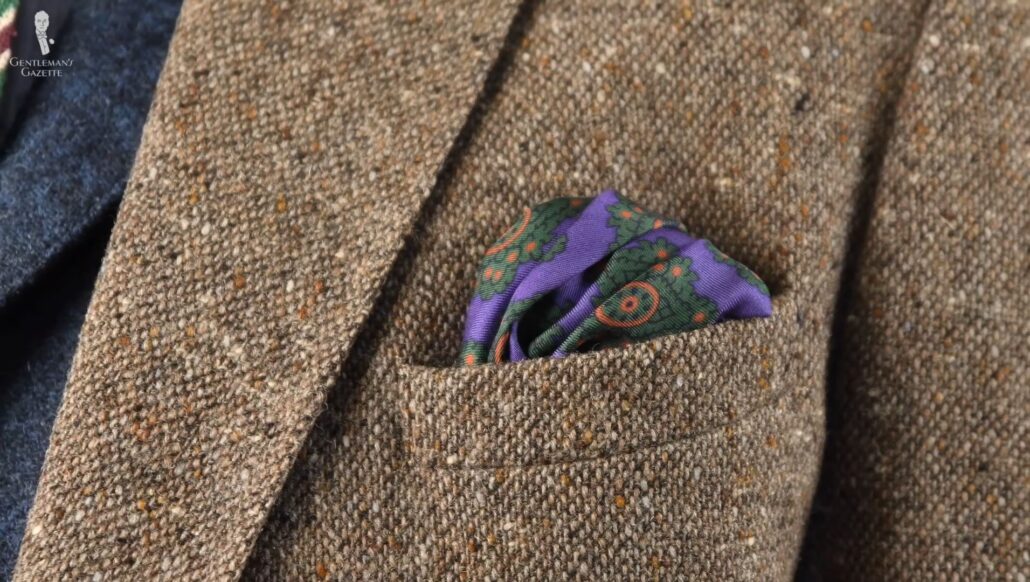
2. The Right Colors
In terms of color, if you focus on subdued yellows, browns, greens, purples, reds, and oranges, you will have a really good starting point. These colors mirror the outdoor environment in autumn in many parts of the world, thus making your outfit feel more at home during the fall-winter season. This is particularly true if you match the colors of your pocket square with the rest of your outfit, because then the environment, your outfit, and your pocket squares all have the same kinds of color hues.
For example, a brown herringbone jacket paired with a striped shirt, a green and red wool challis tie, and a burgundy vest looks great with a pocket square in a silk-wool blend that also contains the colors of brown, burgundy, blue, and green. The brown, yellow, red, and orange tones reflect the foliage outside and make people subconsciously believe that you visually fit in better.
If you have a patterned jacket, tie, and boutonniere, you may be better off to go with a solid pattern on your pocket square, but you can still use the color to pick up those subdued tones.
3. The Right Patterns
Apart from typical fall-winter materials and colors, choosing a pattern for your pocket square can also be a great way to create a superb looking fall-winter outfit. Classics like paisley, no matter whether it’s small or large, look sublime in the right subdued color scheme. Paisley naturally blends itself very easily to incorporate four, five, or even six different colors, thus making it very easy to combine your pocket square and pick up colors of other accessories or elements of your outfit.
As an example, if you have a Donegal tweed jacket and you want the pocket square to pop more, consider utilizing colors that are both rich and bold, and patterns that command a bit of attention.

Other great patterns for fall-winter pocket squares include animals such as rabbits, ducks, dogs, or deer, or any other kind of hunting motifs. Of course, if the color palette is more subdued, you can also choose elephants or scarabs (as we offer at Fort Belvedere). Because of the richness and the multitude of colors, they will work really well with most fall-winter outfits.
If you’re concerned about versatility, make sure to get at least four or more different colors in your pocket square, and life will be a lot easier. Also, keep in mind that more colors make for a more casual look.
Picking a Pocket Square for Fall-Winter Outfits
1. Choose a Color that Contrasts Your Jacket
First of all, you always want a contrast between your pocket square and your jacket. During the fall-winter months, that contrast doesn’t have to be super stark. It can be more subtle, but it has to be visually different and must not blend into your jacket.
2. Pick Up Colors from Your Outfit
Choose a pocket square that contains colors from other areas of your outfit; that could be your tie or your bow tie, your shirt, maybe even your boutonniere, socks, or shoelaces. The goal is to create a harmonious look overall, and you can achieve that in two steps:
- Try to implement several colors of your outfit and have them in your pocket square.
- Have a pattern in your pocket square that is contrasting–meaning smaller or larger–than other patterns in your outfit. We cover this and more of the basic pairing principles in our How To Combine a Pocket Square with a Tie, Suit & Shirt guide.
The more colors of your outfit you can incorporate into your pocket square, the more harmonious the look. Nevertheless, you can have a pocket square with colors that feature nowhere else in your outfit, as long as you also have shades that are featured in such a way.
A great example of this would be a brown Donegal tweed coat with a burgundy waistcoat, a red and white striped shirt, and a cognac peach yellow two-tone knit tie. All these colors are incorporated in the pocket square–but not the blue, and that’s okay! The Edelweiss boutonniere has a bit of blue, but it’s mostly white and picks up the white stripe of the shirt. Of course, you could also skip the boutonniere altogether. Because you have colors other than blue in your pocket square, it provides contrast without feeling detached from the rest of the outfit. This pocket square is versatile and you can basically pair it with any other tweed color in classic menswear.
If you’re not quite ready to invest in fall-winter pocket squares, or if you just want to reuse what you already have, let’s take a look at another outfit. Here, it’s the same Donegal tweed jacket, this time paired with a light blue and dark blue striped shirt, a knit tie in chartreuse green silk, and a light blue silk pocket square from Fort Belvedere. The square is a bit shinier. but it works because it picks up the color tones of the shirt. Because of that, it doesn’t look too formal and it’s still a nice fall-winter outfit.
3. Match Your Pocket Square with Your Vest
You can also coordinate the color of your pocket square with that of your vest (waistcoat). For example, a navy blue pocket square in a wool-silk blend by Fort Belvedere paired with a mid-brown herringbone suit, a white shirt, dark blue tweed vest, and a brown bourette silk houndstooth tie. The textures of this outfit are all very matte and fall-winter appropriate, and while the pocket square harmonizes predominantly with the waistcoat, it also works with a tie, because it has those same color tones.
4. Match Your Pocket Square with Your Shirt
Of course, you can also coordinate the color of your pocket square with that of your shirt, as seen below. Here, we have a gray diagonal twill jacket that’s very tweedy with a very casual denim shirt and the same dark blue pocket square with rabbits in a silk-wool blend from Fort Belvedere.
Next, let’s go over individual color ideas for fall-winter pocket squares.
Blue Pocket Squares
Here’s another example using the same pocket square as before, but this time picking up the blue and beige from the tie and the green from the shirt.
If you want to mix it up, try something like a gray Donegal jacket with a Fair Isle sweater, a blue shirt with white stripes, a white linen pocket square with blue cross stitches along the edges, and a dark blue and light blue two-tone silk knit tie. The pocket square here has more white than blue and the shirt has more blue than white.

In a slightly different outfit, we still have the same gray Donegal tweed jacket with a white shirt with blue checks. The pocket square is solid blue with a whitish string edge, and it all works together. This outfit had it the other way around: the pocket square has more blue and the shirt has more white.
If you want a navy pocket square or something that is a darker blue, make sure you have a jacket that is slightly lighter, so you create enough contrast. For example here, we have a navy blue wool challis pocket square with blue polka dots paired with a houndstooth jacket, a checked shirt, and a navy and light blue two-tone knit tie.
Green Pocket Squares
Next up, let’s take a look at green pocket squares. Green is one of the most underrated colors in menswear, which is why we made a guide on how you can incorporate more green into your wardrobe and look the part.
The first outfit features a dark green silk pocket square from Fort Belvedere that has a small orange micropattern as well as shades of light blue. It is paired with a bluish-green tweed vest, a houndstooth flannel suit in dark brown and off-white as well as a white shirt, and a brown and green striped shantung silk tie. The pocket square picks up the color of the outfit and it’s subdued and elegant, incorporating everything in the pocket square. I also like the differences in texture from the knobby shantung silk and the smooth pocket square along with a coarser jacket.
In this next outfit, we have a green silk-wool pocket square with a paisley pattern that has tones of orange-red and blue it just stands out subtly from the jacket because the wool challis bow tie in orange with green polka dots is already bold enough so the pocket square should be subtle and not overpowering. After all, the pocket square doesn’t stand alone but it’s just part of the look.
If you like blazers, here’s a cool, green fall-winter inspiration for you: navy jacket, white shirt, green and red wool challis bow tie with diamond points, and a large print pattern green pocket square. Once it’s folded, you can’t really see the pattern anymore but you see all the different colors that pick up elements of the outfit and create the desired harmonious look. Note the scale of the pockets work pattern is much bigger than the pattern and the bow tie, therefore, creating that round ensemble.
Orange & Yellow Pocket Squares
Just like green, orange and yellow are quite underrated in menswear (maybe orange more so than yellow). Oranges can be darker or brighter, but especially for pocket squares, the distinction between yellow and orange becomes very fluid. While spring-summer oranges can typically be very bold, it’s not something that works in a fall-winter season, and you should get something that’s a little more subdued instead.
Let’s say you have a bolder patterned jacket such as this Prince of Wales check with a blue over-plaid. You can even forgo the pattern completely in your pocket square, and just show the nice antique gold-orange, yellowish color with the contrasting shoestring edge that picks up the color of the glen check. Beautiful, isn’t it?

The next outfit is really interesting. It is actually a bronze orange madder silk pocket square combined with a green tweed jacket with an orange windowpane, a madder silk tie in ruby red, and a blue shirt. The pocket square provides a nice contrast to the jacket but incorporates the colors of red, green, and orange. Orange also doesn’t have to be the main dominant color in the pocket square, but it can just be an accent color.
Another look here is a different shade of orange in a pocket square mixed with turquoise and coordinating with a tie or the bow tie. That being said, all these concepts of course, also apply to all the other fall-winter colors and you can play and see what works for you. I’m trying to provide you with concepts that you can apply to your wardrobe and what you already have.
For example, this next outfit is very different. It has a yellow pocket square and a yellow knit tie paired with a light blue shirt and a Prince of Wales check cashmere sport coat with a mustard yellow over-plaid. The navy pants and brown shoes allow for a harmonious ensemble because nothing is too loud, but it works because yellow and blue both contribute to the color brown.
Red Pocket Squares
The color red is probably the most popular color for ties and pocket squares in general. For fall and winter, typically your number one color of red is a dark red or burgundy. For example, here is a dark red pocket square that has animal motifs–little rabbits. This is a silk-wool pocket square paired with a tweed jacket and a turtleneck sweater. The rabbits pick up the brown tones of the jacket and the sweater, and the red provides a nice subtle contrast that is noticeable but not too bold.
Here is another silk wool burgundy pocket square. It’s paired with a tweed jacket, a checked shirt, and a red rose boutonniere, and the very same pocket square is used here with a gray Donegal tweed jacket, a burgundy vest, a blue matter silk tie, and a red striped shirt.
And no, we’re not done yet! Here is the same jacket which is part of a suit paired with pink mottled silk in a tie by Fort Belvedere, a blue vest, and a blue shirt. Looks pretty neat, doesn’t it?
Also, keep in mind that red or any other color doesn’t have to be the dominant color. For example, in this outfit, we have this brick red scarab pocket square that also has green and orange. Depending on the way you fold it, different colors can be dominant. For example, here it is paired with an oatmeal-colored herringbone tweed jacket, a Fair Isle wool knit vest, brown corduroys, a pale orange shirt, a burgundy glen check bow tie, and olive green shoes.
Purple Pocket Squares
Just like green, orange, or yellow, purple is not a popular color in menswear because many men are unsure of how to wear it well. Of course, it can be a marvelous color for pocket squares. Naturally, purple can be the main color of a pocket square.
For example, in this outfit, we have a madder silk square with a large diamond pattern in dark green and subdued orange. It picks up the color of the green and purple shantung silk tie in the outfit. Because purple and green are a bolder color mix even when subdued, the tweed jacket, blue tweed vest, and light blue button-down collar shirt don’t steal the show. I’m also wearing a herringbone flat cap as well as blue suede gloves and light brown corduroys.
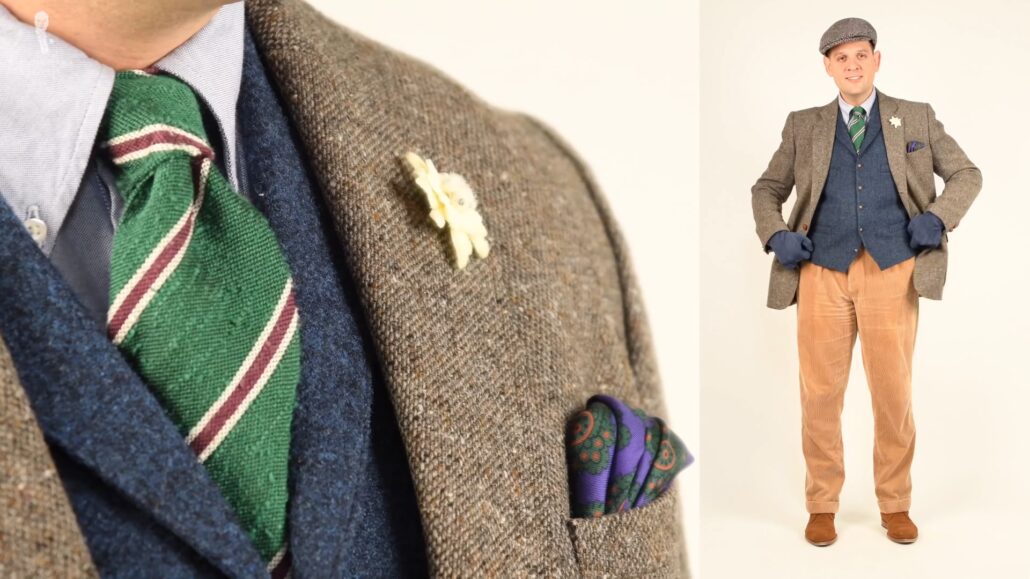
There are certainly bold elements in there but overall, the purple works quite well. It’s maybe a little bit too much to start, but purple can also be worn as an accent color in a pocket square in more advanced ensembles. For example, here, it’s mixed with blue, orange, green, and yellow and because it’s not a strong purple, it combines well with the pale purple shirt. The oatmeal tweed jacket provides a nice background for the pocket square and harmonizes with a brown cardigan knit vest in a glen check pattern. The green in the pocket square also works with the green and the polka-dot linen tie.
Brown Pocket Squares
Last but not least, you may want to consider brown for pocket squares during the fall-winter season. While brown is a prominent color in menswear in general, it’s often neglected when it comes to pocket squares.
A subtle way to incorporate it is to use a pale brown with a linen pocket square with light blue X edges. In this example, they are hand-rolled. The jacket has a fine houndstooth pattern in a brown mustard yellow and navy tone, the vest is greenish or greyish blue, the shirt is off-white and the solid light brown provides just a subtle contrast to the jacket without being distracting at all. That way, the boutonniere, and the green bow tie can shine, but you still have a pocket square that is fall-winter appropriate.
Conclusion
As you can see, a great many options are available to you when selecting pocket squares for the fall and winter seasons. Remember to consider the formality of your outfits, the overall color palette you’re working with, and how bold you’d like your accessories to be, and you’ll be well on your way to looking stylish in cold weather!
How do you style your pocket squares for fall-winter outfits? Share your techniques in the comments!
Outfit Rundown
I’m wearing a casual fall/winter-inspired outfit consisting of a denim blue shirt paired with a navy wool challis pocket square with blue polka dots from Fort Belvedere and they stand out from this houndstooth jacket that is very British and fall-like with some pleats in the back.
The blue dots pick up the color of the shirt and the dark navy provides enough contrast to the jacket. My chinos are sand-colored and they pick up a color from the jacket and the shoes are from Velasca; they’re an oxford semi-brogue in a mid-brown suede that is just a nice fall color.
For my socks, I chose a pair of two-tone solids with dark brown and off-white that work with chinos but provide enough contrast to the shoes and have a kind of textured look to them.
My belt is elastic and it matches the color of the chinos but it also has brown leather elements as well as a gold buckle that works well with my gold ring – the tiger’s eye which has different shades of brown depending on the way the light shines on it.












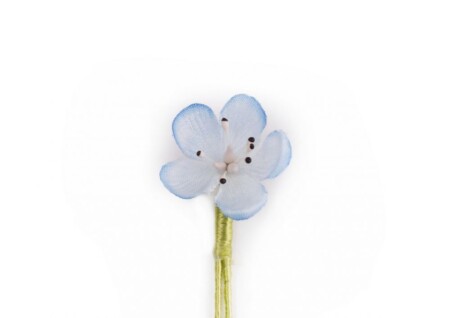
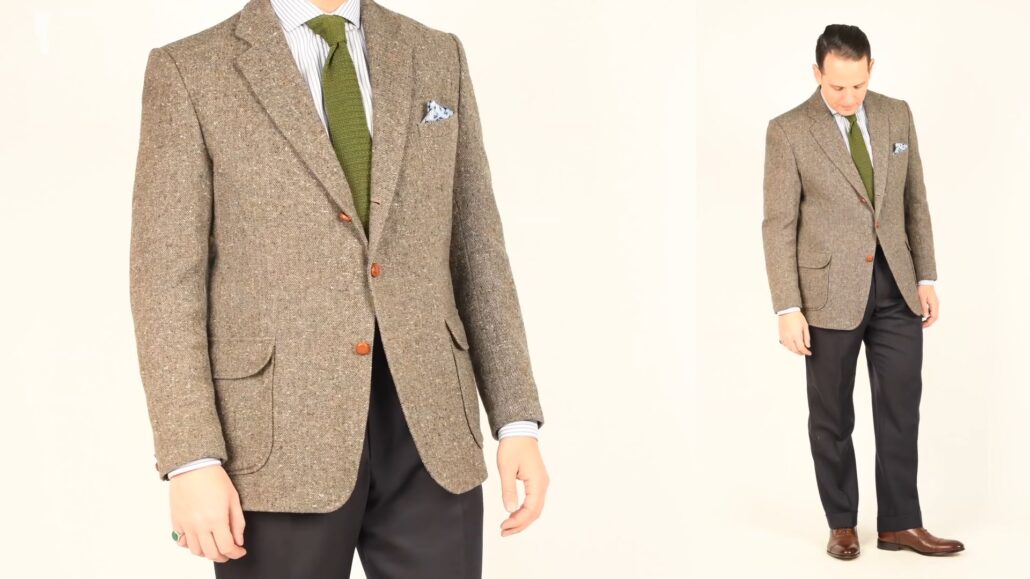






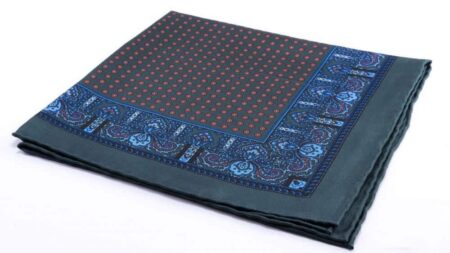
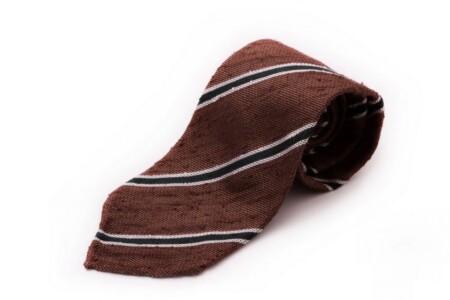






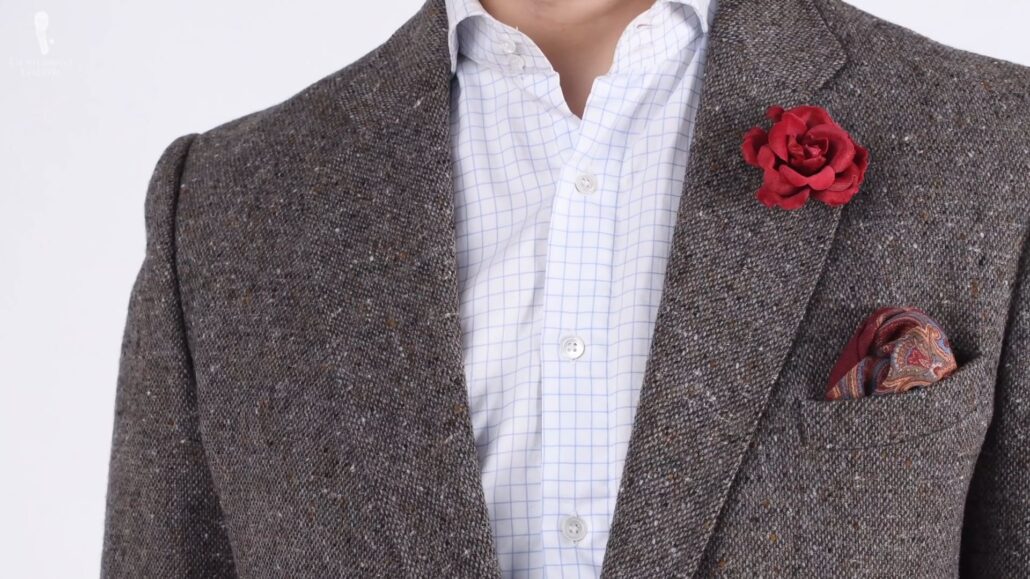











Nice video….but please, PLEASE…..watch the grammar!! At 3:23 you use the term ” more shinier ” ???? Please …it’s SHINIER…NOT more shinier.
Ordinarily, having Fort Belevedere products figure as prominently as they do in this in a video would seem excessive, but in this case it seems to me completely justified by the attractiveness of the products. You have got me coveting those pocket squares!
You know Sven I’ve been a fan for years, but I still am frequently amazed at the beautiful vintage ensembles you create. Confession: a tad envious too. Bravo!
I have loved getting a lot of use out of pocket squares over the years, and have helped several other gentleman “see the light” on their use. For tweed jackets and fall weather, I particularly like madder silk paisley. The subtle shine adds a touch of textural contrast, and the colors can add a very nice palette for the season. I particularly like ones with some burnt orange, especially around the edges.
I really like the editorial content….but some of the ensembles really fall flat…e.g. The “orange(?)” suit with the light colored shoes…ouch!. I think. you need a stylist….sorry.
Once again Raphael a post well done…
Your earlier videos covered the basic proper folds for pocket squares. This, most recent one delves into color palate coordination and contrast, styling, placement and what I call ” the plant.” ( without the plant, beware the disappearing pocket square.)
Regards,
JL
Sven, I’ve noticed many pocketsquares reproducing art, old maps, stained glassed windows, The Bayeaux Tapestry, flags and political parties. The last two are partisan and the rest strike me as a high brow version of a Warner Brother’s cartoon character tie. Some are very attractive. I still get the feeling it would dominate an ensemble to the negative?